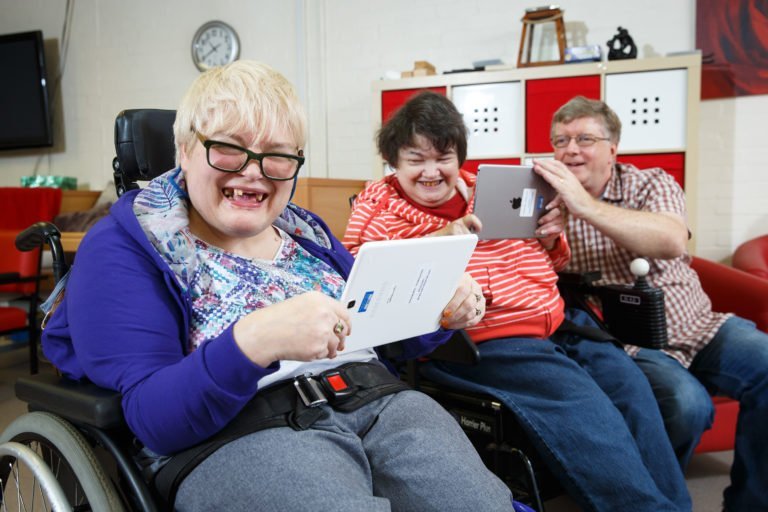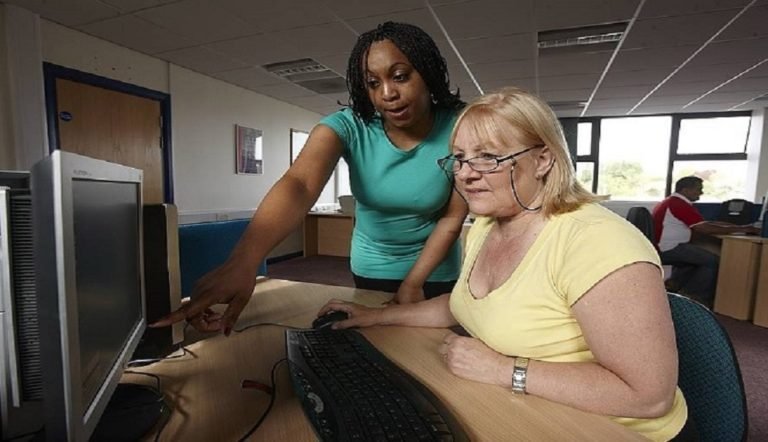7% of adults in Wales today are not online. As more and more vital public services are being delivered online, these people are at danger of being left behind. Organisations which work with the public, particularly in the health and care sector, need to think about how to increase digital inclusion so that everyone in Wales can benefit.
Digital inclusion in Wales

Digital exclusion is not a new issue
Almost 30 years after the launch of the World Wide Web, many people are still excluded from digital services. They still lack the equipment, connectivity, motivation and digital skills needed to make full and confident use of the online services and other opportunities offered by the internet.
7% of adults in Wales are not online
The level of digital exclusion in Wales is higher than in the UK, with as many as 7% of the population, or 170,000 people, not using the internet.
Digitally excluded people are some of the heaviest users of health and social care services, so risk being left behind in the digital health revolution.
Digitally excluded people are likely to be:
Older adults: There is a higher proportion of digitally excluded people in older age groups. Only 41% of people over 75 have basic digital skills, compared with 87% of 16–49-year-olds. Older adults are not, however, a homogenous group. Internet use is increasing among older adults. 61% of people aged 65-74 have all five basic digital skills.
People with disabilities or long-term health conditions: 90% of people with a disability or long-term health condition use the internet, compared with 96% of those without. People with disabilities may require help in identifying appropriate assistive technologies.
Those with lower educational attainment: 93% of those with qualifications at degree level or above demonstrated all five digital skills compared with 51% of those with no qualifications. Many may benefit from more assistance in initial adoption of digital services or in broadening the range of services and activities which they use and participate in online.
Lower income individuals and families: Those who are economically inactive are less likely to use the internet (86%) than those in employment (99%). Lower income families and individuals may be affected by access to and affordability of devices and connectivity. As they may not have access to devices and networks, they may also not have developed digital knowledge, motivation or skills.
People in rural areas: People living in rural areas who are not online are usually excluded due to problems in broadband provision, both for fixed line and mobile broadband services. There are still many areas of Wales affected by not-spots, although the prevalence of these is reported by our case study participants to be diminishing.
Welsh speaking people and others who do not use English as their first language: Digital systems and their associated support processes need to be designed to accommodate the needs of Welsh speakers and speakers of common minority languages. This does require consideration in how services are implemented and supported.
Socially isolated and lonely people: Digital exclusion can be a facet of other social issues faced by individuals, for example, those facing social isolation and loneliness may also be excluded from digital interaction.
Homeless people: It may be assumed that homeless people are excluded as a by-product of their situation. Homeless people, however, include groups that, while they may not have access to permanent housing, may be ‘sofa surfing’ or may be in temporary accommodation such as hostels. Many people in these situations do have access to mobile devices and may face issues of affordable connectivity rather than complete exclusion from digital services.
There are clear public policy and equality reasons for improving digital inclusion, as well as a strong business case.
What are the benefits of being online?
The benefits of being online for people, especially older people, unemployed people and those living in social housing, include:
- Time saved through accessing services digitally.
- Cost saved through accessing services and purchasing goods digitally.
- Reduced loneliness and isolation.
- Increased employability.
- Improved self-care for minor ailments.
- Improved self-management of long term health conditions.
The benefits for organisations, particularly in the health and care system, are:
- Improved take-up of digital tools and services.
- Lower cost of delivering services digitally.
- More appropriate use of services, including advice services, primary care and urgent care.
The most recent analysis of the economic impact of digital inclusion comes in a report prepared by Cebr (Centre for Economics and Business Research) for Good Things Foundation and published in July 2022. This suggests a net present value of providing everyone in the UK with digital skills of £12.2 billion.
Savings by 2032 include:
- Time savings from undertaking government and financial transactions online – £3.9 billion.
- Transactional benefits from shopping online – £3.5 billion.
- Savings to the NHS from reduced GP appointments – £899 million
Digital Communities Wales: Digital Confidence, Health and Well-being can work with your organisation to help you take practical action to support digital inclusion locally. Contact us to find out how we can help.
Use this map to search for somewhere near you for support in using the internet safely.
The statistics in this webpage have been taken from the National Survey for Wales 2021/22 and the National Survey for Wales 2022/23.




